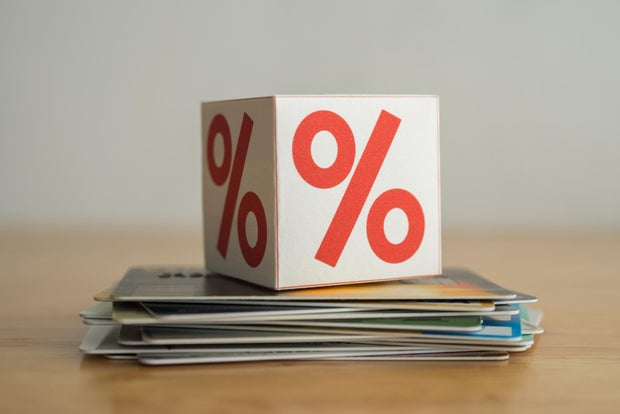Pla2na/Getty Images
The Federal Reserve issued its first rate cut of the year in September — a 25-basis-point reduction that marked a notable shift in monetary policy. But credit card rates have remained largely unchanged, continuing a pattern where they prove resistant to broader market movements.
Credit card users are still facing near-record-high average rates above 20%, creating serious challenges for those carrying balances. With the Fed signaling more potential policy changes ahead, however, many cardholders are wondering if October might finally bring some relief.
We asked some financial experts to explain what’s shaping credit card interest rates and what changes (if any) we might see this month. Below, we’ll break down what you need to know right now.
Start by seeing which debt relief option can reduce your credit card balance here.
Will credit card interest rates fall this October?
Don’t expect much relief, as experts predict minimal changes this month. “If card rates come down at all in October, the reductions will be small,” emphasizes Martin Lynch, president of the Financial Counseling Association of America.
Ronnie Allan, head of consumer credit card and personal lending at PNC Bank, agrees. “While rates may ease slightly, a significant drop is unlikely in the near term,” he says. “Changes may feel modest, as issuers also need to consider broader economic conditions and long-term stability for both the bank and its customers.”
Still, Josh Andrews, a certified financial planner and advice director at USAA, notes that making generalized predictions is difficult given how many variables are at play. Here are three key factors that impact card rates today:
Federal Reserve messaging
The size and tone of Fed rate cuts matter as much as the cuts themselves. “Banks aren’t in a rush to change interest rates if the Fed makes a small reduction without indicating that more significant cuts are coming,” Lynch explains.
The two rate cuts experts anticipate before year-end will likely be modest — just a quarter-point each. If that happens, banks may view it as a signal that the Fed lacks confidence in the economy’s strength. This could make them hesitant to drop their credit card interest rates.
Learn how you could potentially reduce your credit card rates here.
Creditworthiness
“Lenders view your credit score as your personal credit risk or how likely you are to repay money they lend to you,” Andrews explains. “A higher score is generally an indicator of a higher likelihood of repaying a debt.” Borrowers with higher scores are considered riskier, which could be a problem for those who have seen their scores decline during the recent inflationary period.
“Ultimately, banks need to balance competitive pricing with safe and responsible risk management,” Allan adds. So even if the Fed cuts rates, your individual credit profile still determines what rate your issuer offers you.
Economic conditions
Broader economic trends are working against meaningful rate cuts, Lynch says. Inflation remains the top concern for consumers, particularly those living paycheck to paycheck. If recent Fed cuts trigger an uptick in inflation, future reductions become unlikely. At the same time, delinquency rates are climbing, especially among younger borrowers managing student loan payments.
“The U.S. economy depends on consumer spending,” Lynch points out. “But when that spending is on debt repayment and not on consumer goods, unemployment goes up.” Rising inflation and unemployment create a scenario where economic growth stalls. Banks are watching these conflicting signals closely. Until the trends reverse, they’re likely to keep credit card rates where they are.
How to take control of credit card debt today
Rather than hoping for rate relief, financial professionals recommend taking action now. Here’s what they suggest:
- Assess your debt. “List all your credit card debts, including the balance, interest rate and minimum payment for each,” recommends Andrews. Knowing what you owe is the first step toward creating a payoff plan.
- Stop adding to your balances. “Don’t add to your existing credit card debt — instead, use cash or a debit card,” Andrews stresses. “If you’re constantly adding to your credit balance, you can’t dig yourself out.”
- Use the avalanche method. “Pay off the highest-rate card first while maintaining minimums elsewhere,” Christopher L. Stroup, a certified financial planner and president of Silicon Beach Financial, advises.
- Consider consolidation options. Balance transfer offers or personal loans can lock in lower rates and simplify your payments, according to Stroup.
- Automate payments. Stroup suggests setting up autopay to ensure you never miss a due date and avoid late fees.
The bottom line
Credit card rates aren’t likely to move much this month, even with widely expected cuts on the horizon. Waiting for relief could leave you stuck with high-interest debt for months longer.
Fortunately, there are debt relief strategies at your disposal. “Banks offer tools, services and solutions that can help you manage or reduce debt, often at no additional cost,” Allan explains. “These include financial wellness programs, budgeting support and access to lower-rate products.”
If debt still feels overwhelming, consider reaching out to a nonprofit credit counselor for free professional guidance or a top debt relief company for assistance. Often, taking that first step is the biggest hurdle.



